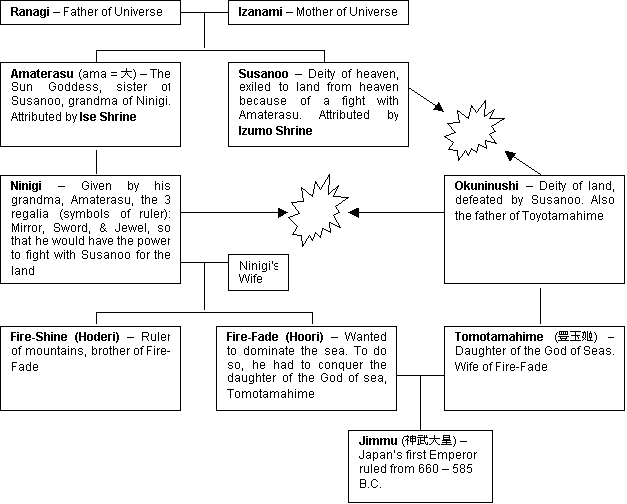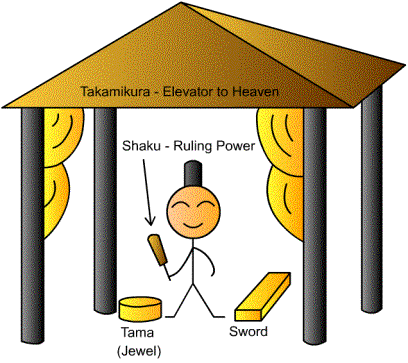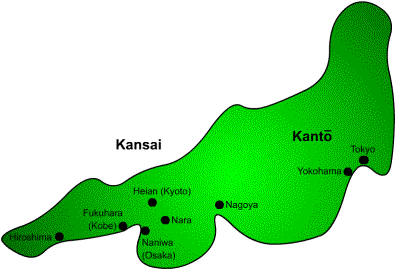The Exams are based on lecture and the textbook Anthology of Japanese Literature.
Scheduled Final Exam is March 21 (Wed) 3 - 6pm.
Meiji period (1868-1912) is a turning point of Japanese culture due to the entry of western cultures. Before Meiji period, Chinese culture was the main way of communication. The westernization.
Anthology of Japanese Literature:
Nara period (  710 - 784 )
710 - 784 )
-
Kojiki (
 ) - means "record of ancient matters", which is also anthology (a collection of poems, stories, songs, excerpts, etc.). Kojiki is the first written record found in Japan in year 712
) - means "record of ancient matters", which is also anthology (a collection of poems, stories, songs, excerpts, etc.). Kojiki is the first written record found in Japan in year 712
- The following is the relationships talked about in Kojiki. Click here for more on Kojiki.

Heisei (1989) is the latest Japanese emperor
Tennoh (  ) - The son of heaven, the king of heaven
) - The son of heaven, the king of heaven
Heika (  ) - Excellency (the emperor)
) - Excellency (the emperor)
Shindo (  ) - the way of God, is a popular religion in Japan that is related to Buddhism.
) - the way of God, is a popular religion in Japan that is related to Buddhism.
In a Shrine, there's always a mirror that symbolize the presence of that particular God.
Enthronement Ceremony of Japanese Emperor:

*Note - The mirror is always kept in the Shrine. Even in the ceremony, it's not bought out.
Meiji period (1868 - 1912) was when the westernization began. It is also called the Meiji Restoration because the emperor's power has gained back from the military. In another way, it could also be called the Meiji Revolution in the sense that a huge amount of knowledge from the west has come to Japan.
Another Important period is the Nara period (710 - 784). It was the first stable power and had the first stable capitol, Nara (  , south of Kyoto).
, south of Kyoto).
 A schematic map of Honshu
A schematic map of Honshu
More on Nara period (710 - 784):
- During Nara period, Kanto area was considered as the place of barbarians. Shogun military power was established in Tokyo area in the Edo period (1600 - 1869).
- Kojiki is a kind of mythology, probably written by Korean immigrants writer(s) working for the emperor. It was established probably in an attempt to imitate Chinese emperor, who had to have their personal history in order to pass the power to their descendents as the legitimate rulers of the country.
-
Sacred Regalia (Matsuri-Goto
 ) - in old terms, it means things related to government and religion; in modern terms, it means festival things.
) - in old terms, it means things related to government and religion; in modern terms, it means festival things.
- Ten Thousand Leaves, poetry on page 759
-
Kotoba (
 ) - words; Ha - leaves
) - words; Ha - leaves
- Kojiki and Manyoshu are the most important literatures in the Nara period
- Read page 33 - 58 in Anthology of Japanese Literature about literature of the Nara period. It will be included into the exam!
- Page 54 in Anthology of Japanese Literature is The Luck of the Sea & The Luck of the Mountains, which represents the symbol of imperial power.
Heian period (794 - 1191): capital was Heian (today's Kyoto)
-
In this period, important literatures include the The Tale of Genji ( Genji Monogatari

 ), which was written by a woman. It implies in the story the power of woman, Murasaki Shikibu.
), which was written by a woman. It implies in the story the power of woman, Murasaki Shikibu.
- The Makioka Sisters is more or less a modern rendering of The Tale of Genji.
The Period of Violence:
-
Middle age ( chosei
 ), Kamakura (
), Kamakura (  1192 - 1333) & Muramachi (
1192 - 1333) & Muramachi (  1334 - 1573 ) were the main periods
1334 - 1573 ) were the main periods
- We will see how violence was portrayed in this period
- Modern novel, Black Rain, is about violence in Japan nowadays
***Then it will be the Midterm Exam!
- Exam question always include:
- 1) Time
2) Authorship
3) The kinds of reader for what purpose
4) How the details fit into the big picture
After the midterm exam, we will continue on the Muromachi period
- Drama - No (theater) plays
Edo period (  1600 - 1869 ):
1600 - 1869 ):
- Drama includes Double Suicide, which is about when you love someone but couldn't marry that person, the only way out was to die together...
- Neo-Confucianism (Chinese thoughts but Japanese feelings, feelings that they were not able to express freely)
-
Kabuki (
 ) - was created in the Edo period. It started out using only female actresses in the plays, but then later turned to using only male actors. It describes Joruri (a kind of singing performance).
) - was created in the Edo period. It started out using only female actresses in the plays, but then later turned to using only male actors. It describes Joruri (a kind of singing performance).
Here for lecture note of Week 2.